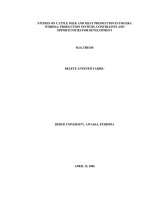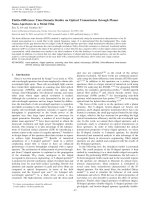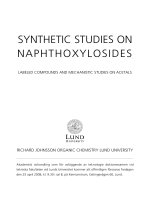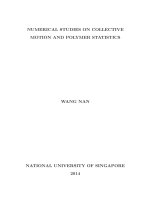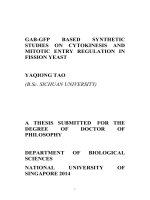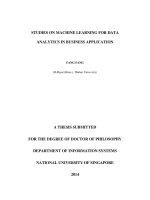Studies on chinas segmented stock markets
Bạn đang xem bản rút gọn của tài liệu. Xem và tải ngay bản đầy đủ của tài liệu tại đây (1.1 MB, 183 trang )
STUDIES ON CHINA’S SEGMENTED
STOCK MARKETS
KONG JING
(MA. SHU)
A THESIS SUBMITTED
FOR THE DEGREE OF DOCTOR OF PHILOSOPHY
DEPARTMENT OF ECONOMICS
NATIONAL UNIVERSITY OF SINGAPORE
2005
Acknowledgments
I am most grateful to my supervisor - Professor Lu Ding for his valuable guidance,
tireless support and continuous encouragement throughout my doctoral study. His
insightful advice charters the direction of my thesis and adds substance and value to
this work.
My special thanks are extended to Professor Xing Xiaolin whose scholarly attitude
and warm personality prove to ease my burden and help to endure the difficult times.
I would also like to acknowledge Professor Yu Qiao, who has shared with me his
research and teaching experience and guided me into the academic world. The
constructive advice provided by Professor Jose Tongzon is greatly appreciated.
Meanwhile I would like to express my gratitude to National University of Singapore,
which provided me a scholarship for pursuing the Ph. D program.
The friendship with other fellow research students has enriched my campus life and
I would especially thank Ms Cheng Ying, Li Ning, Shi Yuhua and Yu Hui for their
encouragement and for being good friends.
I have been heavily indebted to my parents, Kong Bingcan and Zhou Yi, without
their support and sacrifice this thesis would not have been possible. The work is also
dedicated to my husband, Li Xiangdong for his never failing moral support and love,
and to my daughter, Li Zilu for the joy and responsibility brought to my life - all the
difficult times with hardship become joyful moments in front of her beautiful smile.
i
Table of Contents
Acknowledgments i
Table of Contents ii
Summary iv
List of Tables vi
List of Figures viii
Chapter 1 Introduction 1
1.1 Market segmentation in China 1
1.2 Policy-driven markets 2
1.3 Domestic dual listings 3
1.4 Organization of this thesis 5
Chapter 2 Overview of China’s Segmented Stock Markets 7
2.1 Development of two stock exchanges 7
2.2 Ownership structure and state control 9
2.3 Segmented A and B-share markets 12
Chapter 3 Reaction to Regulatory Changes and Policy Adjustments in
China’s Emerging Stock Markets 19
3.1 Introduction 19
3.2 Institution background and stock index performance 22
3.2.1 Regulatory framework governing China’s stock markets 22
3.2.2 Performance of stock market indices 26
3.2.3 The news that rocks stock markets 30
3.3 Literature review, news description and hypothesis development 34
3.3.1 Public news arrival and stock market behavior 34
3.3.2 Regulatory news description 37
3.3.3 Formation of hypotheses 47
3.4 Responses of stock market returns to regulatory events 54
3.4.1 Methodology of modified GARCH model 54
3.4.2 Empirical results without cross-market dummies 60
ii
3.4.3 Empirical results with cross-market dummies 66
3.5 Concluding remarks 71
Chapter 4 Impacts of Domestic Dual Listings on Valuation and Liquidity:
Evidence from China’s Stock Markets 77
4.1 Introduction 77
4.2 Institutional background and data 80
4.2.1 Features of China’s domestic dual listings 80
4.2.2 Sample selection and data sources 85
4.3 Review of literature and development of hypotheses 91
4.3.1 Previous studies on dual listings 91
4.3.2 Relevant studies on China’s segmented stock markets 94
4.3.3 Research hypotheses 96
4.4 Event study of market responses to domestic dual listings 102
4.4.1 Methodology for testing valuation effect 102
4.4.2 Empirical results of valuation effect 106
4.4.3 Methodology for testing liquidity effect 116
4.4.4 Empirical results of liquidity effect 118
4.5 Panel regression for valuation effect 122
4.6 Concluding remarks 126
Chapter 5 Conclusion 131
5.1 Summary and contribution of the studies 131
5.2 Limitation and extension for further studies 134
Bibliography 137
Appendix 1 List of Abbreviations 147
Appendix 2 Index Return Outliers and Their ‘Causes’ 148
Appendix 3 Event Dates and Contents 164
Appendix 4 Codes, Announcement and Listing Dates of Sample Companies 173
iii
Summary
China has a unique stock market structure characterized by investment barriers and
capital control separating domestic investors from foreign investors in the A-share
and the B-share markets. This thesis studies two topics relatively unexplored on
China’s segmented A and B-share markets.
One topic is regarding China’s A and B-share markets’ reaction to regulatory
changes and policy adjustments from 1995 to 2003. By relating the daily return
outliers to the explanatory events identified by news reports and financial analysis
articles, I find that about 50% of largest return outliers are ‘caused’ by regulatory
changes or policy adjustments. Estimation of a modified GARCH (1,1)-M model
indicates some asymmetric market responses to certain categories of regulatory
events in the segmented A and B-share markets. For instance, both the A and B-
share markets respond positively to the market demand boosting policies and
measures, but the B-share markets display stronger reaction and also rise statistically
significantly one trading day before the news is announced. For stock market supply
expansion, domestic investors respond negatively to the A-share market expansion
news while foreign investors respond positively to the B-share market expansion
news. The results also suggest that the regulatory constraint on price limit has been
associated with reduced volatilities in the A-share markets but not in the others. And
I find a stronger spillover effect of regulatory event impacts from the A-share
markets to the B-share markets. The overall results indicate that the foreign B-share
investors are more sensitive to the regulatory changes and have some information
advantages over domestic A-share investors in relation to regulatory changes.
iv
Another topic addresses the impacts of China’s domestic dual listings on valuation
and liquidity. The empirical results uncover utterly different market responses to
domestic dual listings in the segmented A and B-share markets. After dual listings
on the B-share markets, the corresponding A-share prices decrease persistently, with
or without considering market covariance risk. The A-share cumulative abnormal
return drifts downwards and reaches -27.8% 150 trading days after the B-share
listing dates. While upon the announcements of dual listings on the A-share markets,
the corresponding B-share prices rise statistically significantly. But the B-share price
hikes seem only transient. No only do the B-share prices drop on the first two A-
share trading days, but also the B-share abnormal returns in the post-announcement
and post-listing periods are negative and statistically insignificant. The panel
regression also finds that no B-share structural change occurs in the A-share post-
event periods. Liquidity effects of domestic dual listings are also found to be
different. For the shares already listed on the A-share markets, trading volumes drop
statistically significantly in the post dual listing periods. While for the shares
previously listed on the B-share markets, trading volumes increase statistically
significantly in the post dual listing periods. These findings can be explained by the
B-share discounts and are consistent with liquidity hypothesis. However, market
segmentation hypothesis, corporate governance hypothesis and order flow migration
hypothesis can not be used in China’s unique institutional background. In addition, I
find some evidences of information leakage before the dual listing announcements in
the domestic A-share markets while not the foreign B-share markets.
v
List of Tables
Table 2.1 Market Size Statistics of China’s Stock Markets (1992-2003) 8
Table 2.2 Ownership Structure of China’s Listed Companies (1992-2003) 11
Table 2.3 Market Scale and Trading Statistics of China’s A and B-share Markets
(As at the end of 2003) 14
Table 2.4 Shareholder Composition in the Shenzhen Stock Exchange (1992-2003)
16
Table 3.1 Descriptive Statistics and Correlation Matrix of China’s Submarket Index
Returns (1995-2003) 27
Table 3.2 Classification of ‘Causes’ of Fifty Largest Daily Return Outliers in
China’s Submarkets (1995-2003) 33
Table 3.3 Number of Sample Regulatory Events in China’s Submarkets (1995-
2003) 39
Table 3.4 Summary for Securities Transaction Cost Cut (1995 -2003) 44
Table 3.5 Summary for Securities Transaction Stamp Duty Revenue (1995 -2003)
46
Table 3.6 Frequency Distribution of Number of Non-trading Days in China’s
Submarkets (1995 -2003) 58
Table 3.7 Abbreviations and Definitions for the Explanatory Variables in Modified
GARCH(1, 1)-M model 59
Table 3.8 Estimation Results of Modified GARCH (1, 1)-M Model without Cross-
market Dummies (1995-2003) 61
Table 3.9 Estimation Results of Modified GARCH (1, 1)-M Model with Cross-
market Dummies 67
Table 4.1 Number and Distribution of Listed Companies on China’s A and B-share
markets (1992-2003) 86
Table 4.2 A-Share Daily Average Abnormal Returns (AARs) and Cumulative
Abnormal Returns (CARs) around B-share Announcement Dates 108
Table 4.3 A-Share Daily Average Abnormal Returns (AARs) and Cumulative
Abnormal Returns (CARs) around B-share Listing Dates 109
vi
Table 4.4 B-Share Daily Average Abnormal Returns (AARs) and Cumulative
Abnormal Returns (CARs) around A-share Announcement Dates 110
Table 4.5 B-Share Daily Average Abnormal Returns (AARs) and Cumulative
Abnormal Returns (CARs) around A-share Listing Dates 111
Table 4.6 A (B)-share Daily Average Trading Volumes (DTVs) and Standardized
Abnormal Volumes (SAVs) around B (A)-share announcement and Listing
Dates 119
Table 4.7 Panel Regression Results for Domestic Dual Listings around
Announcement and Listing Dates using Modified CAPM Model 124
vii
List of Figures
Figure 3.1 Normalized Daily Closing Prices of China’s Submarket Indices
(1995-2003) 29
Figure 4.1 A (B)-share Cumulative Abnormal Returns (CARs) from Day −25 to
+150 relative to B (A)-share Announcement and Listing Dates 106
viii
Chapter 1
Introduction
1.1 Market segmentation in China
The emerging Chinese stock markets have exhibited many puzzling characteristics
and segmentation is certainly one of the most prominent. China has a stock market
structure characterized by investment barriers and capital control separating
domestic investors from foreign investors in the A-share and the B-share markets
to protect domestic firms from foreign control. Unlike other stock markets, the
markets available to domestic and foreign investors were completely segmented
before early 2001, when the B-share markets were opened to domestic individual
investors with foreign currency savings. And contrary to the existing evidences
that the shares offered to foreign investors are traded at premiums relative to the
shares offered to domestic investors in other countries, China’s foreign B-shares
are unique in that they are traded at large and persistent discounts relative to the
domestic A-shares (Baily et al., 1999).
Previous studies on the behaviors of China’s segmented A-share and B-share
markets have focused on two main tracks: the B-share price discount puzzle (see,
e.g., Ma, 1996; Sun and Tong, 2000; Mei et al., 2005) and the information
linkages and asymmetries between the A and B-share markets (see, e.g., Chui and
Kwok, 1998; Sjöö and Zhang, 2000).
1
This thesis investigates two issues which are relatively unexplored on China’s
segmented A and B-share markets by academic researchers. In particular, I study
China’s A and B-share markets’ responses to regulatory changes and policy
adjustments and the valuation and liquidity impacts of domestic dual listings.
1.2 Policy-driven markets
The Chinese government imposed segmentation on the domestic A and B-share
markets to enable it to best perform the social welfare function (Gordon and Li,
2003). Anecdotal press accounts report that the Chinese stock markets have
reputation of ‘policy-driven’ markets as government involvement is
disproportionately large in stock markets (Heilmann, 2002). It is not surprising as
China’s stock markets have developed in an economy in its transition from a
central planned system to a market oriented system.
However, as far as I know, no systematic and comprehensive empirical study has
been done to examine the impacts of regulatory change and policy adjustment
announcements on China’s segmented stock markets. This study attempts to fill
the void by exploring the A and B-share markets’ responses to regulation and
policy related news, a special kind of market-wide public information.
By relating the daily return outliers to the explanatory events identified by news
reports and financial analysis articles, I find that about 50% of largest return
outliers are ‘caused’ by regulatory changes or policy adjustments. Estimation of a
2
modified GARCH (1,1)-M model indicates some asymmetric market responses to
certain categories of regulatory events in the segmented A and B-share markets.
For instance, both the A and B-share markets respond positively to the market
demand boosting policies and measures, but the B-share markets display stronger
reaction and also rise statistically significantly one trading day before the news is
announced. As for stock market supply expansion, domestic investors respond
negatively to expansion news of the A-share markets but foreign investors
respond positively to those of the B-share markets. The results also suggest that
the regulatory constraint on stock price floating range has been associated with
reduced volatilities in the A-share markets but not in the B-share markets. And I
find a stronger spillover effect of regulatory event impacts from the A-share
markets to the B-share markets than that from the B-share to the A-share markets.
The overall results indicate that the foreign B-share investors are more sensitive to
the regulatory changes and have some information advantages over domestic A-
share investors with regards to regulatory change and policy adjustment news, a
kind of market-wide public information.
1.3 Domestic dual listings
A dozens of listed companies in the Mainland of the People’s Republic of China
(PRC) have issued and listed two different classes of shares on the Shanghai Stock
Exchange (SHSE) or Shenzhen Stock Exchange (SZSE). Both A and B-shares are
identical in terms of voting power and dividend claims with local A-shares
restricted to domestic investors and foreign B-share restricted to foreign investors.
3
Motivation for studying the impacts of China’s domestic dual listings arises from
the increasing literature on the international dual listings as large amount of
companies have their shares listed on the foreign stock exchanges. A few theories
have been involved to explain the motivation and market responses of dual listings,
such as liquidity hypothesis and corporate governance hypothesis (see, e.g.,
McConnell et al., 1996; Doidge et al., 2004). Can these theories be applicable in
China given its unique institutional features? And whether are the impacts of
domestic dual listings different in the A and B-share markets given the large and
persistent B-share discounts? Therefore, the Chinese stock markets provide an
interesting forum for investigating the impacts of domestic dual listings on
valuation and liquidity.
The empirical results uncover utterly different market responses to domestic dual
listings in the two segmented submarkets. After dual listings on the B-share
markets, the corresponding A-share prices decrease persistently, with or without
considering market covariance risk. The A-share cumulative abnormal return
drifts downwards and reaches -27.8% 150 trading days after the B-share listing
dates. While in the B-share markets, upon the announcements of dual listings on
the A-share markets, the corresponding B-share prices rise statistically
significantly. But the B-share price hikes seem only transient. No only do the B-
share prices drop on the first two A-share trading days, but also B-share abnormal
returns in the post announcement and post listing periods are negative and
statistically insignificant. The panel regression also finds that no structural change
4
for B-shares occurs in the post event periods. Liquidity effects of domestic dual
listings are also found to be different. For the shares already listed on the A-share
markets, trading volumes drop significantly in the post dual listing periods. While
for the shares previously listed on the B-share markets, trading volumes increase
significantly in the post dual listing periods. These findings can be explained by
the B-share discounts and consistent with liquidity hypothesis. However, market
segmentation hypothesis, corporate governance hypothesis and order flow
migration hypothesis can not be used in China’s unique institutional background.
In addition, I find some evidences of information leakage prior to the dual listing
announcements in the domestic A-share markets while not the foreign B-share
markets.
1.4 Organization of this thesis
The rest of the thesis is organized as follows:
Chapter 2 presents an overview of China’s segmented A and B-share markets. In
particular, I discuss the development of China’s two stock exchanges, ownership
structure, state control, and characteristics of the segmented A and B-share
markets.
Chapter 3 forms the main part of this thesis and investigates the reaction to
regulatory changes and policy adjustments in China’s segmented A and B-share
markets by employing a modified GARCH (1,1)-M model.
5
Chapter 4 is also the main part of this thesis, which explores the impacts of
domestic dual listings on valuation and liquidity of China’s segmented A and B-
shares by using event study and panel regression methodologies.
Chapter 5 concludes the thesis and recommends some areas for future studies.
6
Chapter 2
Overview of China’s Segmented Stock Markets
2.1 Development of two stock exchanges
There are two national stock exchanges in the Mainland of the PRC – the
Shanghai Stock Exchange, which commenced operation on 19 December 1990
with eight A-shares listed, and the Shenzhen Stock Exchange, which inaugurated
on 3 July 1991 with six A-shares traded. From 1992, the Chinese government
allowed selected lists of firms to issue tradable B-shares to foreign investors. The
B-share of Shanghai Vacuum Electron which listed on the SHSE on 21 February
1992 is China’s first B-share available to non-Chinese investors. Subject to
regulators’ approval, a China domiciled company may list it’s A and B-shares on
the SHSE or the SZSE. However, each company’s shares are restricted to one of
the exchanges, i.e. no company can cross list on both the Shanghai and Shenzhen
stock exchanges. And short-sale of shares is illegal in Chinese stock markets.
Trading is continuously conducted by an order-driven computerized matching
system. In addition to providing places and facilities for trading, the main duties
of the exchanges also include formulating trading rules, publishing trading
information, reporting to regulatory and supervisory authorities and taking
temporary measures to suspend or stop trading. Both exchanges are now open
Monday to Friday. The morning session is from 09:15 am to 09:25 am being the
time for centralized competitive pricing and from 09:30 am to 11:30 am the time
7
for consecutive bidding. The afternoon session is from 13:00 pm to 15:00 pm also
being the time for consecutive bidding.
Table 2.1 shows the annual market capitalization and as a percentage of Gross
Domestic Product (GDP), number of listed companies and investors of China’s A
and B-share markets.
Table 2.1
Market Size Statistics of China’s Stock Markets
(1992-2003)
Market
Capitalization
Market
Capitalization
GDP
Number of
Listed
Number of
Investors
Year (RMB bil) (% of GDP) (RMB bil) Companies (mil)
1992
104.8 4.1% 2,586.4 53 2.2
1993
354.1 10.3% 3,450.1 182 7.8
1994
369.1 7.9% 4,669.1 291 10.6
1995
347.4 5.9% 5,851.1 323 12.4
1996
984.2 14.4% 6,833.0 530 23.1
1997
1,752.9 23.4% 7,489.4 745 33.3
1998
1,950.6 24.7% 7,900.3 851 39.1
1999
2,647.1 32.0% 8,267.3 949 44.8
2000
4,809.1 53.8% 8,935.7 1088 58.0
2001
4,352.2 44.7% 9,731.4 1160 66.5
2002
3,832.9 36.4% 10,517.2 1287 68.8
2003
4,245.8 36.3% 11,689.8 1287 70.3
Sources: China Securities and Futures Statistical Yearbook and IFS, various issues
8
As indicated in Table 2.1, the total size of China’s stock markets has grown
rapidly since their establishment in the early 1990s. The total market capitalization
increases from RMB 104.8 billion at the end of 1992 to RMB 4,245.8 billion at
the end of 2003, with the market capitalization as a percentage of GDP increases
from 4.1% to 36.3% during the same period. The number of listed firms increases
from 53 at the end of 1992 to 1287 at the end of 2003 and the number of investors
increases from 2.2 million to 70.3 million for the same period.
2.2 Ownership structure and state control
One of the unique features of China’s emerging stock markets is related to the
ownership structure of listed companies, which is classified according to the
ownership property of the shareholders and consists of state shares, legal person
shares, employee shares and public shares. State shares are shares owned by
central government, local state government and government authorized agencies
on behalf of the government. Legal person shares refer to shares held by other
state-owned enterprises (SOEs), by government controlled financial institutions,
or by the foreign partners of a corporatized foreign joint stock company.
Individuals are prohibited from holding state shares and legal person shares.
Employee shares are those shares issued to companies’ staff at lower prices when
compared to the A shares sold to public shareholders.
1
Public shares include the
A-shares restricted to Chinese citizens for trading, the B-shares which are also
1
The mechanism of issuing employee shares was abolished at the end of 1998.
9
traded on the SHSE or the SZSE but restricted to foreign investors till early 2001
and oversea listed shares (the H-shares traded in Hong Kong, the N-shares traded
in New York and the S-shares traded in Singapore, etc).
State shares and legal person shares are not listed on the two national stock
exchanges and non-tradable to prevent the supposed leakage of state assets.
Employee shares are also non-tradable, but can be converted into public A-shares
if (a) public A-shares has been issued for at least three years; and (b) conversion
has been approved by the stock exchanges. Only public A-shares and B-shares are
traded on the two national stock exchanges. Since most of the legal person shares
are owned by the SOEs, the government remains the dominant status of state’s
ownership of listed companies by separating tradable and non-tradable shares.
The ownership structure of the Chinese listed companies from 1992 to 2003 is
presented in Table 2.2. On average, the tradable A-shares and B-shares comprise
only 22.9% and 5.8% of the total shares outstanding, while state shares and legal
person shares account for 40.9% and 23.6% of the total shares outstanding,
respectively. The proportion of public A-shares increases from 15.9% in 1992 to
26.7% in 2003, while the proportion of public B-shares decreases from 14.9% in
1992 to 2.7% in 2003. In sum, about two thirds of the total issued shares of the
Chinese listed companies are non-tradable with most take the form of state shares
and legal person shares. The state still controls the majority shareholding of the
Chinese listed companies.
10
Table 2.2
Ownership Structure of China’s Listed Companies
(1992-2003)
Non-tradable Shares Tradable Shares
Year
State
shares
Legal
person
shares
Others Total
A-
shares
B-
shares
H-
shares
etc
Total
1992
42.1% 26.6% 1.2% 70.0% 15.9% 14.9% 0.0% 30.8%
1993
49.1% 20.7% 2.5% 72.2% 15.8% 6.4% 5.6% 27.8%
1994
43.3% 22.5% 1.1% 67.0% 21.0% 6.1% 6.0% 33.0%
1995
38.7% 24.6% 1.1% 64.5% 21.2% 6.7% 7.7% 35.5%
1996
35.4% 27.2% 2.2% 64.8% 21.9% 6.4% 6.9% 35.2%
1997
31.5% 30.6% 3.2% 65.3% 22.8% 6.0% 5.7% 34.6%
1998
34.3% 28.3% 3.3% 65.9% 24.1% 5.3% 4.7% 34.1%
1999
36.1% 26.6% 2.3% 65.0% 26.3% 4.6% 4.0% 35.0%
2000
38.9% 23.8% 1.6% 64.3% 28.4% 4.0% 3.3% 35.7%
2001
46.2% 18.3% 0.8% 65.3% 25.3% 3.1% 6.4% 34.7%
2002
47.2% 17.3% 0.8% 65.3% 25.7% 2.9% 6.1% 34.7%
2003
47.4% 16.6% 0.7% 64.7% 26.7% 2.7% 5.9% 35.3%
Average 40.9% 23.6% 1.7% 66.2% 22.9% 5.8% 5.2% 33.9%
Sources: China Securities and Futures Statistical Yearbook, various issues
Another unique feature of China’s emerging stock markets is that the government
exerts strict control of share issues on the stock markets. Under the old quota
system, the State Planning Committee (SPC), in conjunction with the China
Securities Regulatory Commission (CSRC) set the national quota for the amount
11
of new shares in China. The quota was then allocated among the provinces
according to criteria that support regional development goals, in consideration of
provincial industrial mixes. On 17 March 2000, China unveiled new rules for
applying for initial pubic offerings (IPOs), abolishing its old quota system.
However, stock exchange listings are still under strict state control as it is the
CSRC that has the power to determine the rules and timing of the approval of the
IPO applications.
2.3 Segmented A and B-share markets
The A and B-share markets were intentionally segmented from the beginning of
China’s stock market development. The A-shares were restricted to domestic
investors and traded in China’s local currency, Renminbi (RMB), while the B-
shares were restricted to foreign investors till early 2001 and traded in U.S. dollar
on the SHSE and in Hong Kong dollar on the SZSE. The restrictions imposed in
China are unique, as the markets available to domestic and foreign investors were
completely segmented. While in most other countries, the stock market
segmentation is partial where foreign investors are only allowed to buy the foreign
class of shares and domestic investors can trade both of the local and foreign
shares.
2
2
For detailed description of market segmentation in other countries, please refer to
Hietala (1989) on Finland, Bailey and Jagtiani (1994) on Thailand, Stulz and
Wasserfallen (1995) on Switzerland and Domowitz et al. (1997) on Mexico.
12
On 19 February 2001, the CSRC announced that Chinese citizens would be
allowed to own B-share stocks traded on both the Shanghai and Shenzhen stock
exchanges. However even after this regulatory change, B-share trading by Chinese
domestic investors are still constrained by the availability of foreign currencies as
Chinese currency Renminbi is still not convertible for capital account transactions.
Only domestic individual investors can trade B-shares and domestic institutional
investors are still banned from trading of the B-shares. Therefore till now the
China’s A and B-share markets are still largely segmented as evident by the large
and persistent foreign B-share discounts comparing to the prices of the domestic
A-shares issued by the same listed companies (Karolyi and Li, 2003). While in
most other countries, the foreign shares are traded at premiums (Bailey et al.,
1999).
In addition to the ownership property and trading currency differences, there are a
number of differences between the A and B-shares. First, the B-share markets
have not expanded as rapidly as the A-share markets. Table 2.3 lists the market
scale and trading statistics of China’s A and B-shares as at the end of 2003,
respectively. By the end of 2003, there are 1261 companies that issued A-shares
but only 111 companies that issued B-shares. The A-share float market
capitalization for the tradable shares is RMB 1,230.6 billion and the B-share float
market capitalization is only RMB 87.3 billion. The annual turnover value is RMB
3,127.0 billion for the A-shares but only RMB 84.5 for the B-shares in 2003.
Overall, the B-share markets are much smaller than the A-share markets in terms
of market scale and trading activity.
13
Table 2.3
Market Scale and Trading Statistics of China’s A and B-share Markets
(As at the end of 2003)
A –share B -share
SHSE SZSE Total SHSE SZSE Total
Number of
Stocks
770 491 1,261 54 57 111
Issued Shares
1
(bil)
407.6 173.3 580.8 9.5 9.5 19.0
Tradable Shares
(bil )
106.2 65.57 171.8 9.5 8.5 17.9
Total Market
Capitalization
2
(RMB bil)
2,940.1 1,212.0 4,152.0 40.4 53.3 93.7
Float Market
Capitalization
3
(RMB bil)
779.7 450.9 1,230.6 40.4 46.8 87.3
Trading Volume
(bil )
263.3 136.0 399.2 6.0 11.1 17.1
Turnover Value
(RMB bil)
2,054.1 1,072.9 3,127.0 28.3 56.2 84.5
Notes:
1. Number of issued shares which include both tradable and non-tradable shares
2. Market capitalization calculated based on the issued shares
3. Market capitalization calculated based on the tradable shares only
Sources: Shanghai Stock Exchange Fact Book 2003, Shenzhen Stock Exchange Fact Book
2003 and the CSRC website:
Second, the information disclosure requirements are higher for the companies
with B-shares than those for the companies with only A-shares. The financial
statements of A-share firms should be prepared according to the PRC generally
accepted accounting principles (PRC GAAPs) and audited by locally certified
14
accountants. The financial statements of B-share firms must follow the
International Accounting Standards (IASs) and audited by international audit
firms. The IASs are more conservative than the PRC GAAPs. China’s dually
listed firms need to prepare two sets of financial statements with the differences
between the two sets of numbers disclosed in the PRC GAAP statements (Chen,
Ferdinand and Su, 1999).
Third, the A-share markets are overwhelmed by individual investors while the B-
share markets have much larger participation by institutional investors, especially
before the B-share markets’ opening to domestic individual investors. As at the
end of 2000, 99.59% of the A-share investors registered with the Shanghai Stock
Exchange are individual investors while the rest 0.41% are institutional investors.
5.72% of investors in the Shanghai B-share market are institutional investors. On
the Shenzhen Stock Exchange, institutional investors constitute 0.49% and 6.41%
of the total registered A and B-share investors at the end of 2000, respectively.
3
Table 2.4 shows the shareholder composition in the Shenzhen Stock Exchange
during the period from 1992 to 2003. The proportion of institutional investor
increases gradually from 0.13% in 1992 to 0.52% in 2003 in the Shenzhen Stock
Exchange A-share market and decreases from 28.37% in 1992 to 1.63% in 2003
in the Shenzhen Stock Exchange B-share market, with the sharp drop occurs in
2001. It is generally believed that in China foreign institutional investors have
more sophisticated analytical tools in processing the stock market information (see,
e.g., Chui and Kwok, 1998; Sjöö and Zhang, 2000).
3
Data are collected from the Shanghai Securities Year Book 2000 and the Shenzhen Stock
Exchange Fact Book 2000.
15
Table 2.4
Shareholder Composition in the Shenzhen Stock Exchange
(1992-2003)
1992 1993 1994 1995 1996 1997 1998 1999 2000 2001 2002 2003
A-share Investors
(thousand)
1,050.5 3,532.8 4,830.0 5,550.4 10,895.8 16,097.8 19,010.9 21,859.2 28,303.9 31,652.2 32,593.2 33,213.3
— Individual
1,049.1 3,522.2 4,807.2 5,519.0 10,853.0 16,018.8 18,924.7 21,788.1 28,164.7 31,497.6 32,425.7 33,040.6
by percentage
99.87% 99.70% 99.53% 99.43% 99.61% 99.51% 99.55% 99.67% 99.51% 99.51% 99.49% 99.48%
— Institution
1.4 10.5 22.7 31.4 42.7 79.0 86.2 107.2 139.2 154.60 167.50 172.7
by percentage
0.13% 0.30% 0.47% 0.57% 0.39% 0.49% 0.45% 0.49% 0.49% 0.49% 0.51% 0.52%
B-share Investors
(thousand)
3.7 8.8 11.0 22.3 93.6 102.5 106.3 113.3 129.0 555.9 581.7 601.5
— Individual
2.6 6.8 8.0 18.6 89.1 96.1 99.4 105.8 120.8 547.0 572.4 591.6
by percentage
71.63% 77.09% 72.77% 83.53% 95.16% 93.78% 93.42% 93.37% 93.59% 98.39% 98.39% 98.37%
— Institution
1.0 2.0 3.0 3.7 4.5 6.4 7.0 7.5 8.3 8.9 9.4 9.8
by percentage
28.37% 22.91% 27.23% 16.47% 4.84% 6.22% 6.58% 6.63% 6.41% 1.61% 1.61% 1.63%
Sources: Shenzhen Stock Exchange Fact Book, various issues
16
